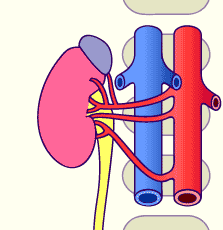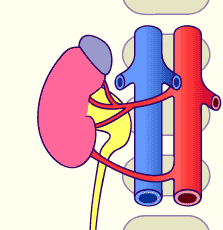|

|
|
|
|
It results from an embryonic developmental stop of the kidney, the structure of which is otherwise normal. The cause is not yet clear and could be connected with problems in the synthesis of growth factors or their receptors during the sensitive phase of metanephrogenesis (17). The kidney is small, whereby the renal hypoplasia must be distinguished from a secondary atrophic kidney, resulting from an infection (chronic pyelonephritis).
|
|
|
|
In an aplastic kidney, a fibroused kidney anlage with its own derivates of the mesonephric duct (Wolffian duct) is present. It represents the extreme form of a renal dysplasia and differs from agenesia, in which absolutely no kidney anlage exists
|
|
|
|
These are seldom and relatively benign. They are more frequent with increased age (0,1 to 4% in children, > 30% in those over 70 years of age). A cyst formation without a dysplasia is involved most of which are acquired. These abnormalities are often asymptomatic; sometimes they are only accidentally discovered in an x-ray of the abdomen. Diagnostically, however, they are sometimes difficult to distinguish from tumors.
|
|
|
|
A renal dysplasia must be distinguished from a simple hypoplasia in which the histological structure is normal. Renal dysplasia is characterized by a congenital anomaly of embryonic renal tissue development. The kidneys develop large epithelial cysts that are localized in the renal parenchyma and lead to the loss of the functional tissue, which can end in renal insufficiency.
One distinguishes among various forms of dysplasia:
|
|
|
- The autosomal, recessively inherited, renal polycystic dysplasia is a rare congenital disease with an incidence of 1/50'000 births. Frequently the diagnosis is made in utero using ultrasound. Depending on when it appears, this disease is divided into neonatal, infantile and juvenile polycystic kidneys. The responsible gene is localized on chromosome 6. The illness manifests itself through a large tumor on both sides. This disease usually leads to a terminal renal insufficiency before adolescence. In the perinatal form, the renal insufficiency appears already in the first weeks following birth.
|
|
|
- The autosomal dominantly inherited renal polycystic dysplasia is a frequent disease and has an incidence of 1/400-1/1'000 births. In approximately 85% of the families that suffer from this illness one finds a genetic anomaly of the PKD1 gene on chromosome 16. The remaining 10 - 15% of the affected families have an anomaly of the PKD2 gene, which is localized on chromosome 4. If one parent suffers from this disease, the risk of this illness in the child is 50%, whereby usually the symptoms do not make themselves felt before 30 years of age. Clinically, cysts are also present, though, in the lungs, liver and spleen.
|
|
|
- The multicystic renal dysplasia is an anomaly that normally appears on only one side (in contrast with a polycystic kidneys which are always found on both sides). The bilateral form is not compatible with survival. The cause of this illness is a differentiation disorder of the fetal kidney, leading to an atrophy of the renal parenchyma, which is replaced by cysts with a yellowish fluid. The ureter is atretic, the vessels are thin and the kidney consists only of a mass of cysts. Usually, over time, the cysts atrophy and for this reason no treatment is required. When the other kidney is normal, this has no consequences. The multicystic kidney can present as an isolated abnormality, but it can also be associated with the trisomy 13, a syndrome with numerous abnormalities, or with the autosomal, recessively inherited Meckel's syndrome.
|
|
|
Vascular anomalies of the kidney
|
|
|
|
There are many arterial and venous variants of the renal blood supply, reflected in the changing blood supply of the migrating kidneys during their development. As seen in autopsies 39% of the kidneys have only one artery and vein. In the majority, the partly embryonic arteries do not completely degenerate. Variants are found with deviant or additional vessels. Thereby normal intersegmental arteries are involved that arise directly from the aorta or veins that discharge into the vena cava and reach the upper or lower renal pole. If such a vessel goes from the aorta to the lower renal pole, the ureter can be compressed, leading to a hydronephrosis. Incidentally the arterial variants are twice as frequent as the venous ones. In a surgical operation these morphologic vessel variants must be given special attention since terminal vessels (with no anastomosis to other vessels) are involved.
|
|
|
| Fig. 35 - Multiple renal arteries |
|
Fig. 36 - Artery at the lower renal pole |
|
Legend |

|
|

|
|
Fig. 35
Here a kidney is shown with several renal arteries that are drawn to the upper and lower poles of the right kidney.
Fig. 36
An artery goes from the aorta to the lower renal pole, leading to a blockage of the ureter with a dilated renal pelvis on this side.
|
|
|

